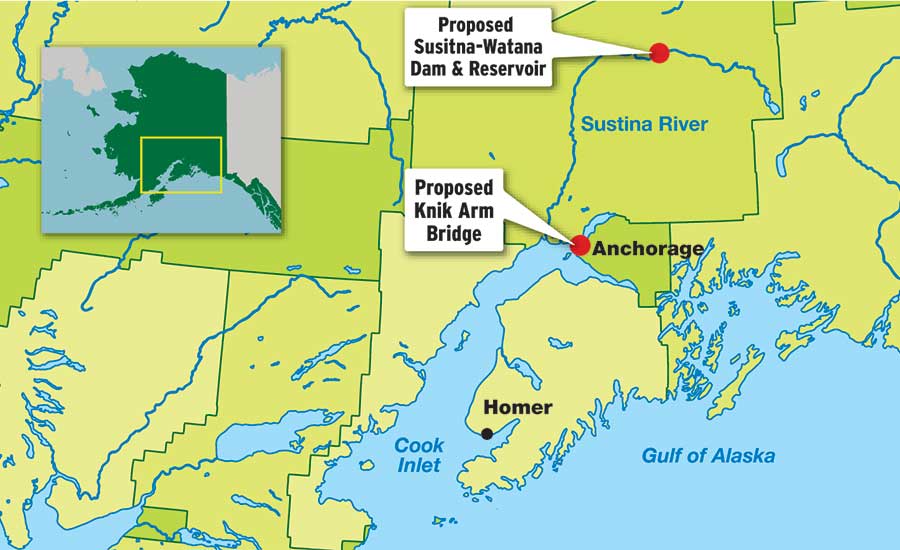
Alaska’s financial difficulties led Gov. Bill Walker (R) to shut down two slow-moving megaprojects before construction started on either.
As part of more than $1 billion in far-reaching statewide budget cuts, Walker put a hold on several projects, including two grandiose ones: the Knik Arm Crossing project, a planned $1-billion, 1.74-mile bridge, connecting Anchorage to Point MacKenzie over Cook Inlet; and the Susitna-Watana Hydroelectric Project, which featured a 705-ft-tall dam and a 42-mile-long reservoir, estimated at $5.2 billion total.
“I ran for governor to build Alaska, not to balance the checkbook,” Walker says. “We’re balancing the checkbook because that’s the hand we were dealt. It pains me to shut down anything involving a construction project or an infrastructure project.”
Walker says the studies and planning for both projects will be preserved, “but those projects … we can no longer continue to advance” in the current economy.
Along with the megaprojects, eight state-funded road projects worth $250 million were placed on pause.
Railroad engineers envisioned the Knik Arm Crossing as a railroad span in 1923, but it never advanced beyond the conceptual stage. Revived in a 1972 engineering study, Rep. Don Young (R) championed the project, which critics dubbed a “bridge to nowhere.” Design, permitting and preliminary construction work occurred between 2003 and 2010. The Alaska Dept. of Transportation & Public Facilities took charge in 2014 and noted that roughly $85 million had been spent with minimal progress.
Jeremy Woodrow, department spokesman, says the project was waiting on a permit from the federal government. “While waiting for federal action, work has been minimized,” he said. “Future progress on the bridge requires more fiscal certainty, given the bonding necessary and the cost increase associated with bonding as a result of the state’s credit-rating downgrade.”
The Knik Arm project did have the potential of future federal funding components; now, any federal authority that was envisioned will be programmed to other Alaska state transportation needs, Woodrow says. Up to $5 million could be returned to the state from this project alone.
The changes to the controversial Susitna-Watana project, managed by the Alaska Energy Authority (AEA) and costing about $180 million to date, puts the kibosh on plans to build the nation’s second-tallest dam on the country’s fourth-longest undammed river.
The Susitna River Coalition, a key player in the fight against the project, praised the decision to mothball the dam and vowed to ensure it wouldn’t return. Opposition centered on both the far-reaching environmental impacts of the impoundment and its questionable fiscal benefit.
“We applaud Governor Walker for making the right decision during these tough fiscal times,” says Emily Anderson, the senior program manager for Alaska at the Wild Salmon Center, a key partner with the Susitna River Coalition. “This project would have wreaked havoc on the river, harmed important local tourism and recreation-based economies, and set a very bad precedent for future energy development on our salmon rivers in the state.”
WSC and the coalition claim that the dam, a massive concrete structure that would create a huge reservoir and change river patterns, would harm all five species of wild Alaskan salmon.
An economic analysis by Erickson & Associates says the dam would have drained state funds. “A well-documented history of projects managed by AEA and its predecessor, the Alaska Power Authority, shows a consistent pattern of underestimated costs,” principal Gregg Erickson writes. “Susitna will require substantial state assistance, draining the treasury of reserves needed to forestall a hard landing for the state budge and economy.”
Construction of such a large project at the site’s high altitude without a completed design or concrete-mix plans, Erickson says, adds complications “likely to be associated with underestimated costs.”



Post a comment to this article
Report Abusive Comment